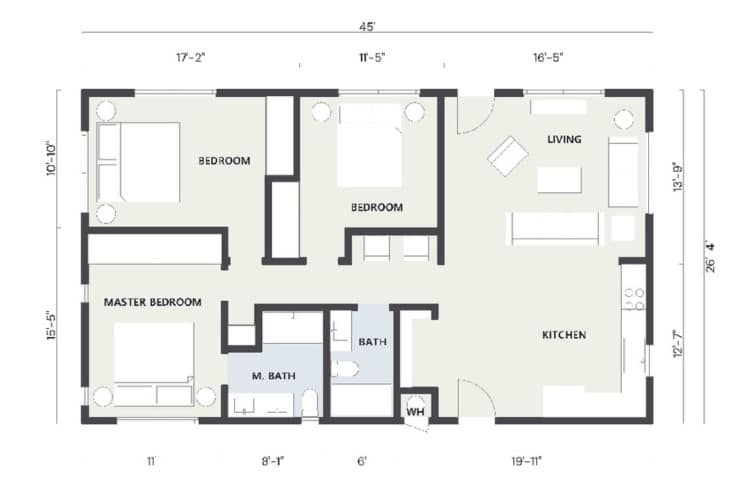Is it Worth It To Build An ADU in 2025? Assessing the ROI of Building an ADU
15 min read
Building an Accessory Dwelling Unit (ADU) in 2025 is absolutely worth it, especially in high-demand markets like California, where the rental market remains robust. ADUs give homeowners strong financial returns. These come from rental income, higher property values, and flexible multi-generational living spaces. However, achieving a complete ROI depends on careful planning, understanding local market dynamics, and selecting the right type of ADU for your specific property and investment goals.

What is the Return on Investment (ROI) for an ADU in 2025?
Adding an Accessory Dwelling Unit (ADU) can deliver strong financial benefits through increased property value, steady rental income, and long-term appreciation. According to the FHFA, “in 2023, the median appraised value increased to $1,064,000 and $715,000 for properties with and without ADUs.” With California seeing the appraised median value for properties with ADUs record annualized growth of 9.34% from 2013 to 2023.
So, it’s clear that adding an ADU gives you an advantage in increasing your home’s value. But to make informed decisions on what works best for your unique situation, it’s critical to use the correct ROI formula—and to understand that many numbers presented often blend multiple factors in a way that inflates the result.
ROI = ((Property Value Increase − Cost) ÷ Cost) × 100%
This measures value gain only and excludes rental income, which should instead be tracked as a cash-on-cash return.
Blended ROI (value gain + first-year gross rent) can give a broader “total return” snapshot, but is not the industry-standard ROI. Combining these without distinction can make the investment look better on paper than it is in reality.
ROI by ADU Type in San Diego
San Diego’s high-demand housing market makes ADUs attractive, but your best choice depends on your goals:
- Detached ADUs: Maximum living space and long-term equity growth, but the highest upfront costs.
- JADUs and Garage Conversions: Lowest costs, fastest payback, and strongest short-term cash returns—ideal for owners focused on quick ROI from rentals.
The table below shows:
- Cost ranges based on current San Diego/SoCal builder data
- Typical property value increase as a percentage, not a fixed dollar amount
- True ROI (value only) and Blended ROI (value + first-year rent) using mid-range assumptions
- Cash-on-cash return and payback period
San Diego Reality Check
Local builders report that most detached ADUs in San Diego County budget at $350K–$450K+ all-in for 750–1,200 sqft units. Smaller attached or conversion ADUs can cost much less, but site conditions, utility upgrades, and permitting can add substantially to the totals.
Key Takeaways
- True ROI is often lower than marketing claims, especially for detached and attached ADUs.
- Blended ROI adds rent and gives a more complete picture of first-year returns but isn’t a pure ROI metric.
- Cash-on-cash return is the correct measure for annual rental yield.
- Payback period shows how quickly rental income covers build cost—and is often the most tangible decision metric for homeowners.
(Sources: Angi, Great Buildz, Cottage)
| ADU Type | Typical Build Cost (San Diego) | Typical Value Increase (% of home value) | True ROI (Value Only) | Blended ROI (Value + Rent | Monthly Rent | Annual Rent | Cash-on-Cash Return | Payback Period |
|---|---|---|---|---|---|---|---|---|
| Detached ADU | $300K–$450K+ | +25–35% | ~25–35% | ~40–55% | $2,500–$4,000 | $39,000 | 10–15% | 6–10 yrs |
| Attached ADU | $150K–$300K+ | +20–30% | ~20–30% | ~35–45% | $1,800–$2,800 | $27,600 | 10–18% | 5–8 yrs |
| Internal/Conversion | $100K–$200K+ | +20–35% | ~20–35% | ~40–60% | $1,500–$2,500 | $24,000 | 12–24% | 4–7 yrs |
| Garage Conversion | $80K–$200K | +15–30% | ~15–30% | ~35–55% | $1,500–$2,500 | $24,000 | 15–30% | 3–6 yrs |
| JADU | $60K–$150K | +10–25% | ~10–25% | ~30–50% | $1,200–$2,000 | $19,200 | 15–32% | 2–5 yrs |
Which Type of ADU is the Most Valuable in 2025?
When determining the most valuable Accessory Dwelling Unit (ADU), homeowners must consider both the total value added and the return on investment (ROI). In 2025, Detached ADUs generally provide the highest absolute property value increase, while Junior ADUs (JADUs) and Garage Conversions offer exceptional value per dollar invested.
Detached ADU — The Equity Powerhouse
Detached ADUs create the largest total increase in property value, especially in high-demand markets like San Diego, where privacy and extra square footage drive buyer competition. Ideal for:
- Substantial new square footage (800–1,200 sq ft).
- Complete privacy and independence for occupants.
- Highest rental income potential, ranging from $2,500–$4,000 monthly.
Best for: Maximum property value boost, long-term equity strategy.
Attached ADU — The Space Saver
An attached ADU offers much of the functionality of a detached unit but at lower cost and with shared infrastructure. They’re great for:
- Mid-sized budgets ($150K–$300K+)
- Properties with limited yard space
- Balancing rental income with family use or multigenerational living
Best for: Flexible use, balanced cost and value.
Internal Conversion — The Hidden Asset
Conversions of basements, attics, or other interior spaces can quietly add substantial value without expanding the footprint of your home.
- Uses existing square footage — less impact on lot space
- Moderate cost with strong rental appeal
- Ideal for homeowners in high-density areas where expansions are restricted
Best for: Leveraging unused space, preserving yard area, and moderate budgets.
Garage Conversion — The Cost-to-Value Champion
Garage conversions transform existing structures into income-generating assets quickly, with lower permitting hurdles and shorter build times. They shine when:
- Budget is $80K–$200K
- You want strong ROI from rental income without a massive capital outlay
- Time-to-market matters — these can rent out in as little as a few months
- Strong rental potential ($1,500–$2,500 monthly) and ROI reaching 70–80% in favorable markets (ELMNTL)
Best for: Quick turnaround, strong rental ROI, minimal site disruption.
Junior ADU (JADU) — The ROI Sprinter
The smallest of the bunch, JADUs maximize existing space (150–500 sq ft) and require minimal construction. They often offer the fastest payback period in the ADU category.
-
Lowest upfront investment ($60K–$150K)
-
Attractive rents for size ($1,200–$2,000/mo)
-
Popular in areas where zoning caps the number or size of units
- Lowest upfront cost (approximately $40,000) coupled with high relative returns (80% average ROI) (Neighbor)
Best for: Low-cost entry into the rental market, rapid payback.
Key Factors Determining ADU Value Addition
Several critical factors influence the ultimate value that an ADU will add to your property:
- Urban areas such as Los Angeles, San Francisco, and San Diego typically see higher ADU value increases due to strong housing demand (HapiHomes).
- Optimal size (600–800 sq ft) and thoughtful, functional layouts significantly enhance value.
- High-quality finishes and premium materials can boost property value by an additional 15–25%.
- Greater privacy, especially in detached units, substantially increases both rental and resale value.
- Properly permitted ADUs ensure maximum appraisal value and easier resale.
- ADUs generating higher rental income naturally achieve higher appraisal values and greater market appeal.
Bottom Line
- If you want absolute value growth, go detached.
- If you want fast ROI and low entry cost, go JADU or garage conversion.
- If you want balanced functionality and market appeal, choose attached or internal conversions.
What You Need to Know About Building an ADU
Before discussing the specifics of costs and benefits, it’s crucial to understand the basics of building an ADU on your property. An ADU is a secondary housing unit on a single-family residential lot. These units can be attached or detached Granny Flats or even converted from existing spaces like garages or basements.
How much does an ADU cost to build?
The cost to build an ADU in California varies a lot. This depends on location, size, construction type, materials, and site conditions. This is true especially in markets like San Diego, Los Angeles, and the Bay Area. In 2025, homeowners can expect to spend between $75,000 and $450,000+, depending on the ADU type.
Let’s break down average costs, square footage, and permit fees by ADU category:
Detached ADUs
Detached ADUs are standalone structures separate from the main house. Detached ADUs offer maximum privacy, full independence, and the most design options. But they need the most infrastructure. This detached construction includes new foundations, plumbing, electrical, and HVAC systems.
- Average Total Cost: $350,000
- Construction Cost Range: $110,000 – $450,000
- Average Cost per Sq Ft: $350
- Size Range: 400 – 1,200 sq ft
- Permit Fees: $5,000 – $15,000
In cities like San Diego, detached ADUs typically cost between $375–$600 per square foot for turnkey construction. A 500 sq ft detached unit might cost around $300,000, while a 1,200 sq ft version can climb to $450,000+. (Source: Better Together Builder)
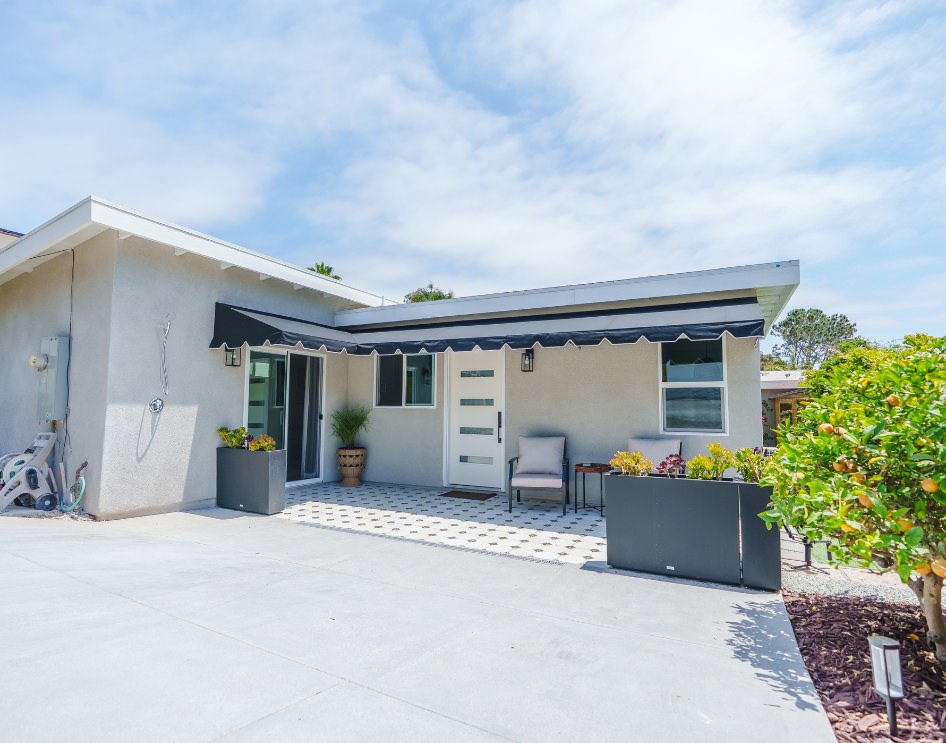
Detached ADUs maximize privacy and rental appeal, ideal for long-term investments and premium tenants.
Attached ADUs
Attached ADUs are ground-up construction units physically connected to the primary home, typically through a shared wall. They still need independent systems like kitchen, bathroom, and entrance. But they can cut costs by using existing utility hookups and structural parts.
- Average Total Cost: $245,000
- Construction Cost Range: $100,000 – $300,000
- Average Cost per Sq Ft: $275
- Size Range: 300 – 800 sq ft
- Permit Fees: $3,000 – $12,000
Attached ADUs strike a great balance between functionality and cost-efficiency. In most cases, they range from $150–$400 per square foot depending on complexity and finishes. (Source: Angi)
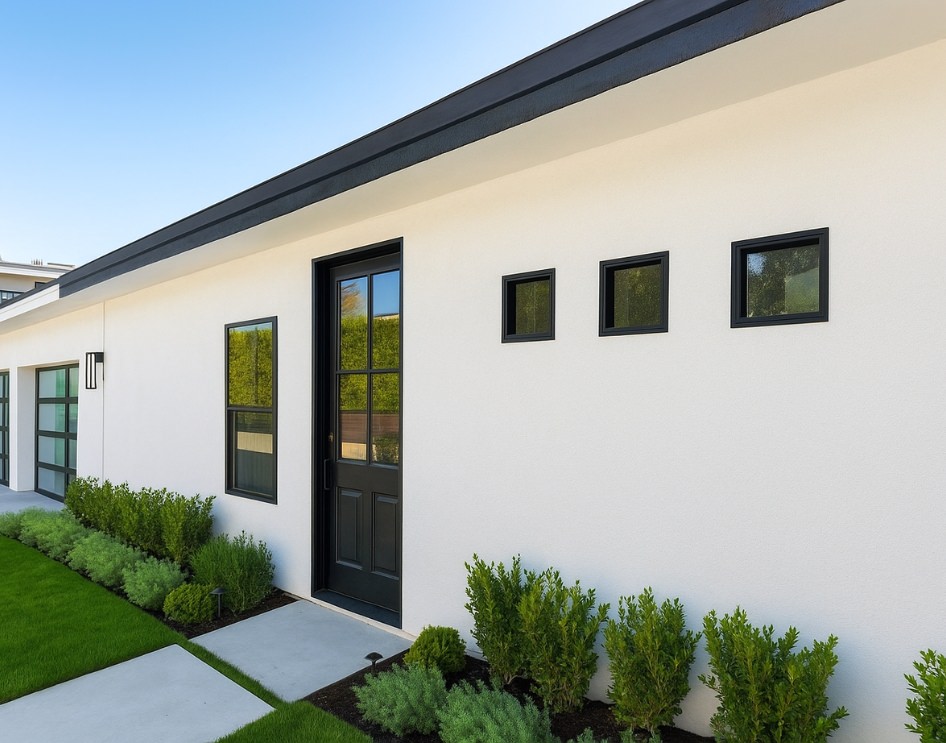
Attached ADUs blend cost-efficiency and utility convenience, perfect for balanced ROI and living flexibility.
Garage Conversion ADUs
Garage conversions are one of the most budget-friendly ADU types, offering a high return on investment by transforming existing space into functional housing. They usually keep the original structure and slab foundation. This reduces construction costs a lot.
- Average Total Cost: $145,000
- Construction Cost Range: $50,000 – $175,000
- Average Cost per Sq Ft: $200
- Size Range: 240 – 800 sq ft
- Permit Fees: $2,500 – $10,000
A simple one-car garage conversion starts around $90,000, while detached two-car garage conversions with more extensive upgrades can approach $150,000–$175,000. (Sources: DYM Builders, Angi, ADU West Coast)

Garage conversions are an economical way to create rental spaces quickly, leveraging existing infrastructure.
Junior ADUs (JADUs)
JADUs are compact, standalone units (under 500 sq ft) built within the existing walls of a home—often converting a spare bedroom or portion of a garage. They share facilities (e.g. bathrooms or kitchens) with the main house, which drastically reduces build and utility costs.
- Average Total Cost: $75,000
- Construction Cost Range: $20,000 – $100,000
- Average Cost per Sq Ft: $200
- Size Range: 150 – 500 sq ft
- Permit Fees: $1,500 – $5,000
Some basic JADU conversions cost as little as $10,000–$30,000, while high-end upgrades with kitchenette and full insulation reach $90,000–$100,000. (Source: Jean Prescott Studio)
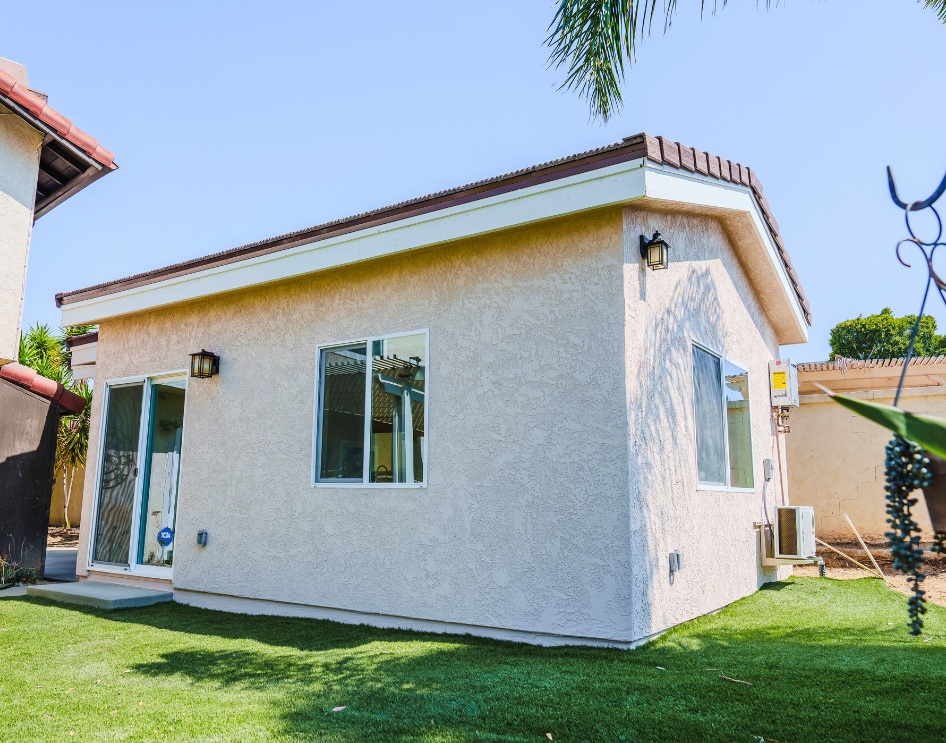
JADUs offer the highest ROI with minimal upfront costs, ideal for first-time investors and small budgets.
Regional Cost Variations Across California
Location is one of the biggest cost drivers for ADU construction. Here’s how detached ADU costs vary regionally across California: (Source: Angi)
| Region | Cost Range for Detached ADU | % Premium Over CA Average |
|---|---|---|
| San Francisco Bay Area | $210,000 – $630,000 | +40% |
| Los Angeles | $195,000 – $585,000 | +30% |
| San Diego | $180,000 – $540,000 | +20% |
| Orange County | $188,000 – $563,000 | +25% |
| Sacramento | $150,000 – $450,000 | Baseline |
| Central Valley | $128,000 – $383,000 | –15% |
What Impacts the Cost of Building an ADU?
Several key factors influence the overall cost of building an ADU, each contributing uniquely to the budget and planning considerations. Here are the primary elements to consider:
Size and Economies of Scale
The size of an ADU significantly impacts costs, creating a nuanced relationship between unit size and per-square-foot pricing. Larger ADUs need more materials and labor, so total costs rise. But they benefit from economies of scale. This lowers costs per square foot.
- Smaller Units (200-500 sq ft): $350-$600 per square foot
- Larger Units (1,000+ sq ft): $150-$300 per square foot
For example, a 1,200 sq ft ADU could cost between $240,000 and $360,000, whereas a smaller 500 sq ft ADU would cost significantly less, proportionately (Source: CA ADU Experts).
Location and Regions
Your ADU’s location greatly affects costs. This is due to regional differences in labor rates, building materials, and local rules. For instance, estimated ADU construction costs in San Diego typically range from $230,000 to $270,000, with permitting alone costing $4,000 to $7,000 over a period of two to three months (Source: Jean Prescott Studio).
Custom Design and Professional Fees
Custom design and complex architecture greatly affect project budgets. Professional architectural design services typically represent 10-15% of total project costs. Architect fees can range from $5,000 to over $30,000, depending on project complexity, with hourly rates of $100–$250 for licensed architects or $50–$150 for architectural designers (Source: CAD Crowd).
Material Selection
Choosing premium or luxury materials can significantly inflate your ADU’s final budget. High-end finishes such as granite countertops, hardwood floors, or custom cabinetry can add 20–30% to the total construction costs. Conversely, selecting standard or mid-range finishes can help control expenses and keep your project within budget (Source: Construct Estimates).
Labor Costs
Labor generally accounts for the largest share of ADU construction expenses, representing 40–60% of the total cost. In California, these labor costs are driven higher by prevailing wage laws, skilled labor shortages, and the high demand for construction professionals. Additionally, general contractor fees typically add another 10–20% to overall project costs (Source: Construct Estimates).
Site Conditions
The existing conditions of your property significantly influence the complexity and cost of your ADU project. Factors like lot slope, need for extra excavation or foundation support, utility availability, and site access can all raise costs.
Permits, Impact Fees, and Regulations
Permitting and impact fees vary widely and are particularly significant cost factors in California. While ADUs smaller than 750 square feet are exempt from impact fees statewide, larger ADUs may incur fees between $3–$4 per square foot. In certain cities like San Diego, these fees can range significantly higher—from $13 to $28 per square foot—for larger units (Source: Autonomous). Local permitting requirements and regulatory compliance can further increase both cost and project timeline.
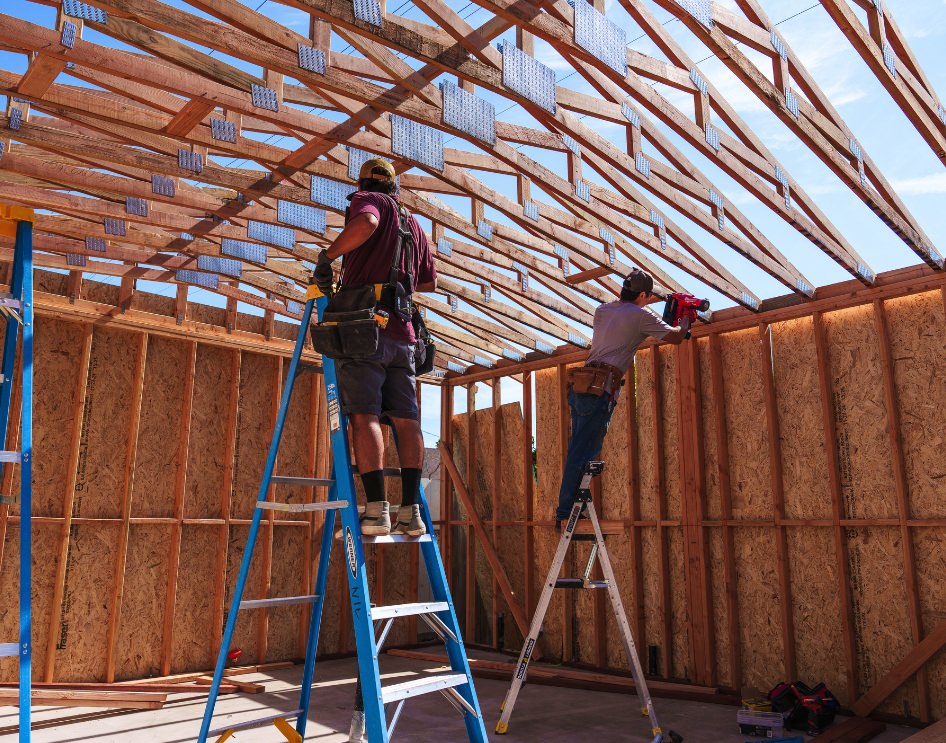
Site conditions and skilled labor heavily influence ADU construction costs—budget accordingly.
Why ADUs are increasingly popular?
ADUs have experienced a surge in popularity in California and beyond due to their practical advantages, legislative support, and their role in addressing the ongoing housing shortage. Recent regulatory reforms have streamlined approvals, lowered fees, and encouraged homeowners to build ADUs, leading to significant growth.
According to the Cato Institute, “The number of ADU permits granted in California increased greatly following the 2019 reforms. After staying relatively stable between 2019 and 2020, permits increased 61% between 2020 and 2021. Between 2019 and 2022, the number of ADUs permitted grew 88%. Constructed ADUs follow the same general trend, rising from 5,852 in 2019 to 17,460 by 2022 (an almost 200% increase).” This rapid expansion underscores how effectively ADUs meet critical housing needs and provide a true ROI and impressive returns as cost-effective rental units.
Easy Solution to the Housing Crisis
One of the most compelling reasons behind the surge in ADU popularity is their role in mitigating America’s severe housing shortage. Currently, the U.S. faces a deficit of approximately 6 to 7.3 million homes, and ADUs offer a unique way to expand housing supply without requiring additional land development. Notably, in California alone, ADUs accounted for 20% of all new home construction in 2023, doubling their share from 2020 (Source: New Frameworks).
Streamlined Permitting and Reduced Regulatory Barriers
Recent legislative changes have significantly simplified the approval process for ADUs, making them more accessible for homeowners:
- Faster Approvals: Local agencies now have just 60 days to approve or deny ADU applications. With pre-approved plans, this timeframe can shrink to as little as 30 days (Source: Perpetual Homes).
- Ministerial Review: ADUs get a mandatory ministerial review. This removes uncertainty by stopping discretionary approvals and public hearings
- Fee and Requirement Waivers: ADUs under 750 square feet are exempt from impact fees, and larger ADUs pay reduced fees proportional to their size. Additional reforms include waived minimum parking requirements, setback reductions to just 4 feet, and the elimination of minimum lot size restrictions.
Income Generation and Financial Benefits
Building an ADU gives homeowners big financial opportunities. By renting out an ADU, property owners can generate rental income that helps offset construction costs and potentially provides long-term profitability. Over time, this income stream can also enhance financial stability and homeowner security.
Flexibility and Multi-Use Adaptability
ADUs offer great flexibility. They let homeowners change their living spaces to fit changing family needs. They can serve as guest suites, multi-generational housing solutions, rental properties, or comfortable home offices. This versatility ensures ADUs remain highly valuable and relevant long-term.

ADUs address housing shortages efficiently, appealing widely due to eased regulations and economic benefits.
How much does an ADU increase property value?
Building an Accessory Dwelling Unit (ADU) is a proven strategy to significantly boost your property’s value. The exact amount of value increase can vary widely, influenced by factors such as ADU quality, location, local housing market conditions, and buyer demand.
National Average Value Increase
On average, homeowners across the U.S. see a 20–35% increase in property value when adding an ADU, compared to similar homes without one (Source: ELMNTL). The National Association of Realtors says homes with ADUs usually sell for about 35 percent more on average. This is especially true in places with housing shortages like California.
Regional Variations in California
The property value boost from an ADU can vary significantly depending on the specific California market:
- California overall: Homes commonly see value increases ranging from 25–50%, with high-demand areas like Los Angeles occasionally reaching up to 58%.
- San Diego: Typical increases range from 25–35%, with exceptional cases seeing property values rise by as much as 50%.
- Bay Area: An analysis covering over 1,000 ADU projects in similarly competitive markets (such as Seattle) found that property values rose by an average of 39%.
(Source: Waymaker Realty Advisors)
Appraisal Insights
Professional appraisers acknowledge that ADUs add considerable value, typically increasing a property’s appraised value by 10–20%. Jun Ho Lee, an experienced appraiser based in San Gabriel, emphasizes that the location significantly impacts how much value an ADU can add (LA Times). It is hard to assess ADU value accurately. This is because few homes with legally permitted ADUs have been sold, so there are limited comparable sales.
Superior Market Performance
Homes featuring ADUs often demonstrate stronger performance on the real estate market, notably:
- Faster sales: Homes with ADUs tend to sell around 26% faster, typically closing nearly a month sooner than comparable homes without ADUs.
- Broader appeal: ADU-equipped properties attract diverse buyer segments, including investors, multigenerational families, and individuals seeking flexible living and workspace solutions.
(Source: Waymaker Realty Advisors)
Strong Return on Investment (ROI)
Properties with ADUs often deliver substantial returns:
- Typical ROI around 50%, with potential exceeding 100% when factoring in ongoing rental income.
- Annual returns from renting out ADUs typically range from 8–12% in competitive rental markets.
- Long-term appreciation for properties with ADUs averages about 9.3% annually, surpassing the 7.7% rate for properties without ADUs (Angi).
Increasing Recognition and Standardization
As ADUs become increasingly popular and widely accepted, their value contribution is becoming more standardized in real estate appraisals. According to the Federal Housing Finance Agency (FHFA), properties with ADUs have experienced notable growth in median appraised values, signaling broader market acceptance and recognition of their added value (FHFA).

High-quality ADUs significantly boost property values, attracting buyers and tenants seeking premium accommodations.
Analyzing the ROI by ADU Type
Detached ADUs – High Investment, Substantial Returns
Detached ADUs require the highest upfront investment due to complete infrastructure development but deliver significant value increases averaging $367,500. They command the highest rental incomes of $2,500–$4,000 per month, though their ROI percentage (60%) and cash-on-cash returns (10%) are relatively lower compared to other types. The typical payback period is around 6.4 years.
Attached ADUs – Balanced Option
Attached ADUs present a middle-ground solution, providing flexibility in design and functionality while keeping construction costs moderate (average $175,000). These units yield strong rental incomes ($1,800–$2,800 monthly) and deliver solid ROI averaging 65%, with a payback period of about 6.3 years.
Internal/Conversion ADUs – Cost-Effective Solution
Internal conversions leverage existing home infrastructure, keeping average construction costs around $105,000. They offer excellent ROI averaging 70%, and consistent rental income between $1,500–$2,500 per month, resulting in a reasonable 4.4-year payback period.
Garage Conversion ADUs – Excellent Value
Garage conversions offer one of the best combinations of low costs ($75,000 average) and strong returns. They typically generate rental incomes from $1,500–$2,500 monthly, achieving an average ROI of 70%. Due to efficient use of existing structures, garage conversions offer exceptional cash-on-cash returns (20%), with a quick 3.1-year payback period.
Junior ADUs (JADUs) – Highest ROI Potential
JADUs deliver the strongest ROI metrics among all ADU types, primarily due to minimal construction requirements and affordability (average cost $40,000). Despite smaller rental incomes ($1,200–$2,000 monthly), JADUs offer outstanding average ROI (80%) and excellent cash-on-cash returns (20%). With the shortest payback period (2.1 years), JADUs represent an attractive entry-level investment, especially appealing to first-time ADU investors.
(Sources: Neighbor, ELMNTL, LoopNet, Aggregate Construction Group)
Additional Factors Influencing ADU ROI
- Understanding local market dynamics, housing demands, and rental trends can greatly enhance your ADU’s ROI.
- Properties with ADUs typically appreciate at a higher annual rate (9.3%) compared to properties without ADUs (7.7%), further increasing long-term returns (Angi).
- Exploring financing options, incentives, and government programs available in California can significantly reduce upfront expenses, thus improving your immediate ROI.
Annual Rental Income Overview
The annual rental income varies considerably by ADU type, impacting overall returns and cash flow:
- Detached ADUs: approximately $39,000 annually
- Attached ADUs: approximately $27,600 annually
- Internal/Garage Conversion ADUs: approximately $24,000 annually
- JADUs: approximately $19,200 annually
While detached and attached ADUs generate higher total rental income, JADUs and garage conversions provide superior returns relative to their initial investment, making them especially attractive for investors prioritizing immediate cash flow.
(Source: GatherADU)

Choosing the right ADU type significantly impacts ROI—balance your goals between immediate returns and long-term appreciation.
Conclusion
Building an ADU can be a wise investment, offering increased property value, rental income, and versatility. However, it’s essential to consider the initial construction costs, ongoing maintenance, and local regulations. ADUs generally provide a high return on investment through increased property value and rental income, making the initial investment worthwhile. They also offer versatile living spaces that can adapt to changing needs.
At Better Place Design & Build, we understand that the process can feel overwhelming. Whether you’re near La Mesa or Pacific Beach in San Diego, we’re here to help. We’re the best ADU builders in San Diego, dedicated to making your next ADU project a success. Get started with us and schedule your free consultation today to take the first step toward your dream ADU.
FAQs
The high cost of construction is a significant drawback. Expenses can vary widely depending on the type of ADU and include costs for permits, materials, and utility connections.
The ADU planning process should align closely with your goals to maximize rental returns, enhance your entire property’s value, and deliver a consistent annual return. For rental income, design the space with an open layout, efficient storage, and a private entrance. If you’re creating a multi-generational living space, prioritize accessibility and flexibility for changing family needs. For a home office, plan dedicated workspaces with ergonomic design, reliable high-speed internet, and modern technology to boost productivity and property market value, whether converting existing spaces or undertaking ground-up construction.
Building an ADU would be wise, offering increased property value, rental income, and versatility. However, it’s essential to consider the initial construction costs, ongoing maintenance, and local regulations.
ADUs generally provide a high return on investment through increased property value and rental income, and could be worth the initial investment. They also offer versatile living spaces that can adapt to changing needs.
Yes, adding an ADU can be a strong investment. According to a San Diego market insights report, the “average ADU adds $280,000 to property value, representing a 30‑40% increase in home value for San Diego properties” (ikkonic.com). Additionally, ADUs generate consistent rental income and provide versatile spaces that can adapt to evolving needs, making them well worth the initial investment.
Yes, an ADU could increase your property value, often by 20-35%, depending on the local housing market and the quality of the ADU.
The average cost of ADUs is expensive due to high construction costs, permitting fees, utility connections, and the need for skilled labor and quality materials.
While it’s possible for an attached or detached ADU to be larger than the main house, local zoning laws and regulations typically restrict the size. Always check with local authorities to ensure compliance.
Building an ADU is usually easier and cheaper than adding a house addition. This is because ADUs need less structural work and can use prefabricated parts.
Turning your ADU into a rental property can generate substantial rental income, especially in high-demand areas. The income can help offset mortgage payments and other expenses.
Building multiple ADUs can offer economies of scale, potentially reducing the per-unit and overall cost of the ADU. However, it’s essential to consider local regulations and market demand before proceeding.

